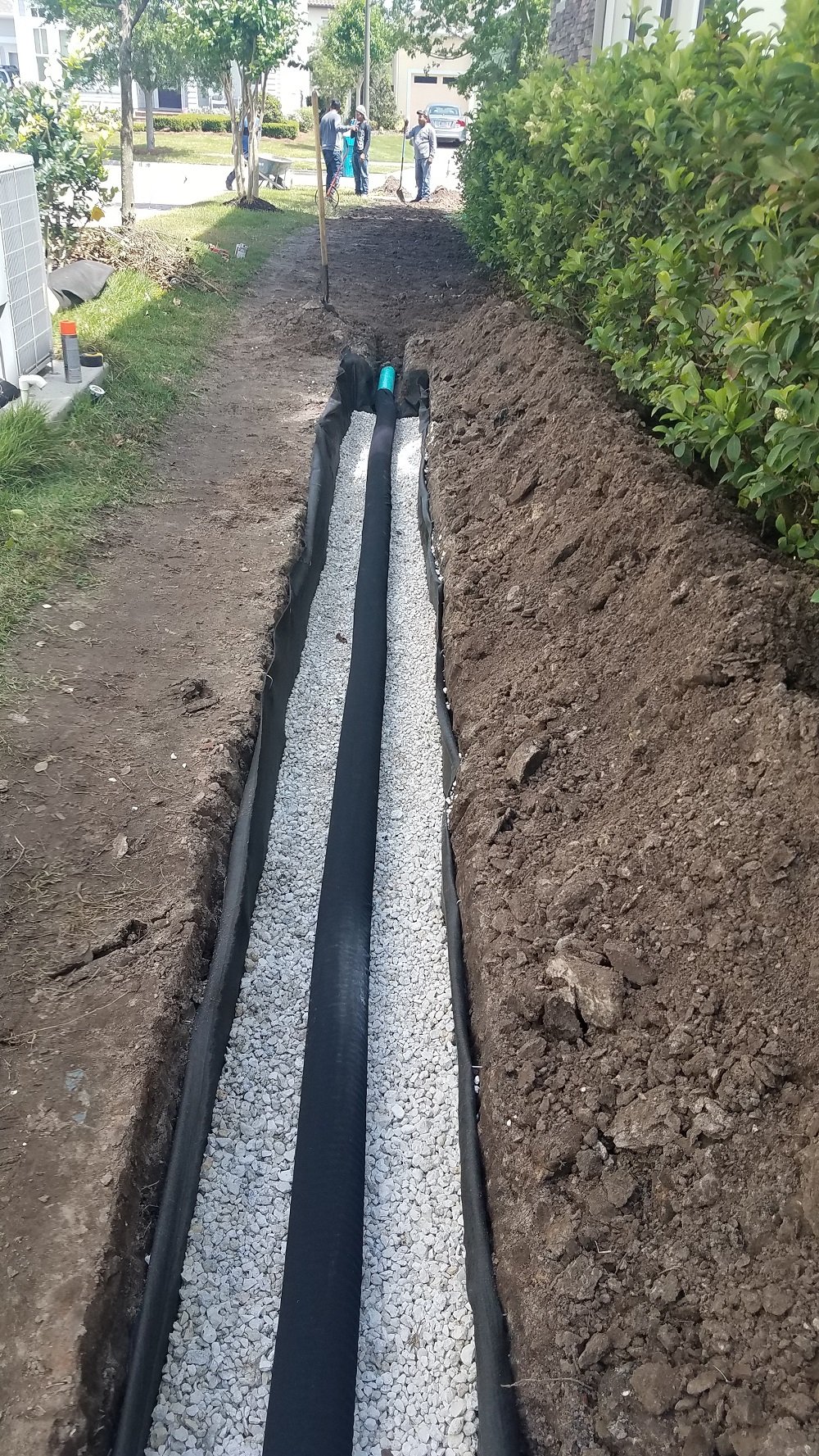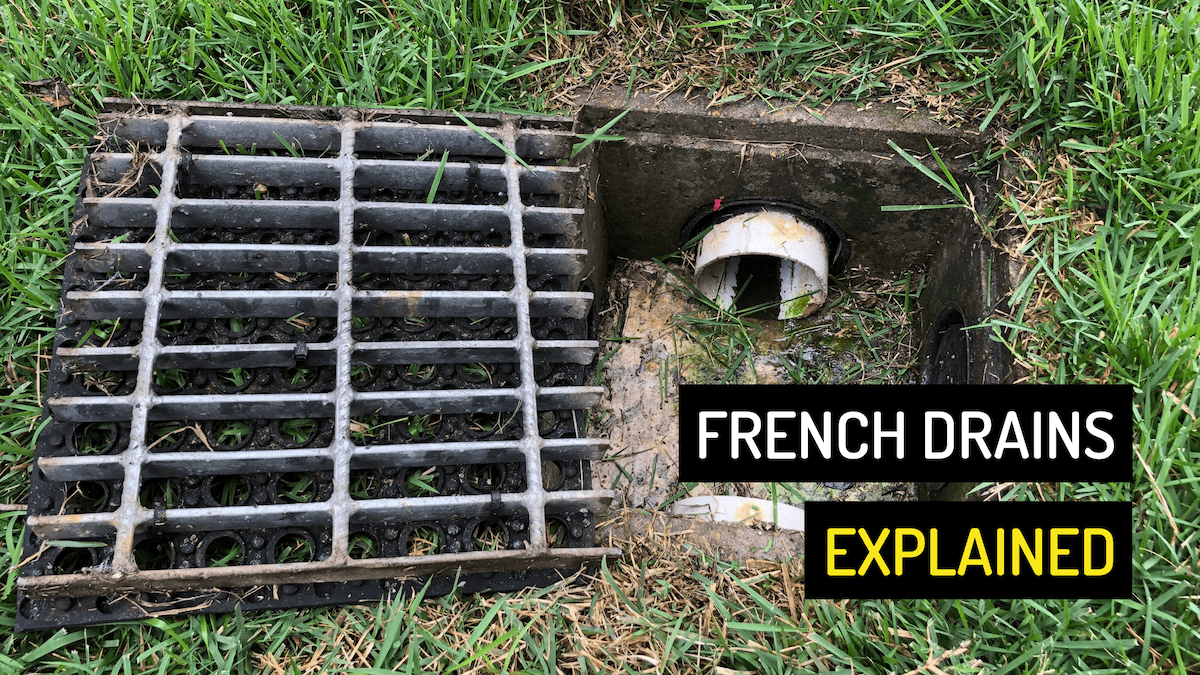The Essential Guide to Keeping Your French Drainpipe for Lasting Efficiency
Maintaining your French drain is vital to its efficiency and your residential property's security. Regular checks can conserve you from costly repairs and water damage. You'll would like to know what indicators to seek and exactly how commonly to evaluate your system. Plus, recognizing the cleaning process can make a significant distinction. Let's discover the crucial steps for guaranteeing your drain operates well for many years to find.
Understanding the Feature of a French Drainpipe
A French drainpipe is a vital element in managing water around your home. It guides excess water away from your foundation, avoiding flooding and damages. When hefty rainfall drops, the drain accumulates water through a perforated pipeline buried in gravel. This system enables water to flow openly, decreasing pressure on your basement wall surfaces and lessening the danger of leaks.You may wonder just how it works in technique. As water fills the dirt, gravity draws it toward the drainpipe. The perforated pipeline catches this water, carrying it to a designated drainage location or storm sewage system. This procedure keeps your yard completely dry and protects your home's structural integrity.Understanding exactly how a French drainpipe functions is key to valuing its value. By successfully directing water away, it aids preserve a secure and completely dry living environment. So, maintaining your French drainpipe in top problem warranties you stay clear of costly repair services down the line.
Routine Inspections: What to Look For
Begin by inspecting for any clogs that could be blocking water circulation when you're inspecting your French drainpipe. Focus on signs of surface area erosion around the drain, as this can indicate potential issues. Normal assessments will aid keep your drain system working properly.
Blocked Drainpipe Assessment
How can you inform if your French drainpipe is blocked? Initially, expect water merging in your backyard, specifically after heavy rain. That's a red flag if you see locations where water collects instead of draining pipes. You must also examine the drainpipe outlet; if water isn't spurting as it should, there's likely a clog. Pay attention for unusual gurgling audios, which can suggest trapped air. In addition, evaluate the drainpipe's surface area for any type of plant life growth, as roots can obstruct the system and infiltrate. If you smell musty smells, it could direct to stagnant water created by an obstruction. Regularly evaluating these indicators can assist you preserve your French drainpipe effectively and prevent pricey repair work.
Surface Disintegration Examine

Cleaning Your French Drainpipe: Step-by-Step Overview
Cleansing your French drain is crucial for maintaining it functioning properly. You'll need some particular devices and a clear procedure to assure everything runs efficiently. Let's walk through the steps and tips for preserving your drainpipe properly.
Devices You'll Need
To tackle the task of cleaning your French drain efficiently, you'll wish to gather a couple of necessary devices. First, grab a durable set of gloves to protect your hands from particles and sharp things. A tiny shovel or trowel will certainly help you eliminate dirt or blockages around the drain. For cleaning out the interior, a plumbing professional's serpent or a high-pressure water nozzle can be unbelievably beneficial. You'll additionally need a pail for collecting any kind of debris you draw out. Finally, having a garden hose handy will certainly make it simpler to rinse out the drain and ensure it's streaming smoothly. With these devices all set, you'll be set for an extensive cleaning session!
Cleansing Process Actions
Start by assessing the area around your French drainpipe for any visible particles or clogs. Eliminate leaves, branches, or dirt that might obstruct water flow. Next, check the inlet and outlet locations; clear any type of obstructions to assure appropriate drain. Make use of a yard hose pipe to purge the drain, directing water right into the inlet. This assists dislodge any kind of collected sludge or sediment. Think about using a plumbing professional's snake to damage them up if you discover persistent obstructions. After cleaning, check the gravel around the drain; renew it if it's removed. Verify the drain covers are intact and safely in location to protect against debris from getting in. Regular cleansing maintains your French drainpipe functioning efficiently.
Upkeep Regularity Tips
While routine maintenance is crucial for your French drain's longevity, knowing how commonly to keep it can make all the difference. Preferably, you should examine your French drain a minimum of twice a year, ideally in springtime and autumn. After hefty rains or snowmelt, look for blockages or debris. If you observe any type of standing water, it's time to clean your drain.In locations with hefty vegetation, more frequent maintenance-- concerning every 3 months-- may be required. Furthermore, take into consideration cleansing your French drainpipe after major storms or this post if you observe water pooling in your yard. By staying positive, you'll ensure your French drainpipe features properly and protects your property from water damage. Regular checks will save you time and money in the lengthy run.
Determining Usual Concerns and Their Solutions
When you notice water pooling in your yard or damp spots in your basement, it's important to determine typical problems with your French drainpipe and apply effective services. One frequent problem is blocking, commonly triggered by debris like leaves or sediment. To repair this, you can make use of a pipes snake or a high-pressure water jet to clear blockages.Another problem might be improper incline. If your drainpipe isn't sloped appropriately, water will not stream away from your home. You can adjust the incline by digging and rearranging the drainpipe pipe.Lastly, check for damages or splits in the drain itself. Replacing the harmed sections is vital for peak performance if you find any kind of. By attending to these issues promptly, you'll aid ensure that your French drainpipe proceeds to function properly, securing your building from water damage and keeping a completely dry, risk-free atmosphere.
Seasonal Maintenance Tips for Your French Drain
Dealing with common problems with your French drain is just the initial step in ensuring its long-term efficiency. Seasonal upkeep is crucial for peak efficiency. In the spring, eliminate leaves and debris that may have gathered throughout winter months. Look for any type of blockages in the outlet or catch basin, as water requires a clear path to stream freely.During summertime, check your drainpipe for any type of signs of changing or clearing up soil. Make sure it's still degree and functioning effectively. As fall strategies, clean any type of dropped leaves to stop clogs before winter months arrives.In winter, watch for freezing temperature levels. Make certain your drain isn't at risk of cold if you live in a cold climate. Protecting exposed pipelines can help. Normal checks and timely maintenance can protect against expensive repair work and keep your French drain working successfully year-round. Stay positive and appreciate satisfaction recognizing your drainage system is in good condition!
When to Hire an Expert
Recognizing when to call a professional can conserve you time and prevent further damage to your French drainpipe. It's a clear sign that your drainpipe might be obstructed or damaged if you observe persistent standing water in your backyard. Do not neglect strange odors, as they can suggest sewage backup or degeneration, which requires immediate attention.If you find that your drain isn't functioning properly after attempts to tidy or preserve it, it's time to connect for expert aid. Furthermore, if you're unclear about the underlying problems or do not have the essential devices, hiring a professional can supply peace of mind.Finally, if your French drain is old or has actually experienced significant deterioration, specialist evaluation can determine whether repair work or complete substitute is required. Trust the experts to ensure your water drainage system works efficiently for many years ahead.
Tips for Protecting Against Future Drain Troubles
To maintain your French drainpipe operating efficiently, frequently evaluating and keeping it can make all the difference. Beginning by clearing debris, leaves, and dust from the surface area and drainpipe openings. This protects against clogs that can result in water backup. Check the gravel around the drain; if it's compressed or deteriorated, consider adding fresh crushed rock to keep suitable flow.Next, divert water away from your drain by guaranteeing seamless gutters and downspouts are clear and routing water at the very least three feet far from your foundation. Consistently check for any type of indications of damage or sagging. If you see concerns, resolve them immediately.Finally, consider installing a catch or a filter basin to catch bigger debris before it enters the drainpipe. By remaining aggressive with these suggestions, you'll decrease the risk of future drain problems and maintain your French drainpipe in top form.
Frequently Asked Concerns
For how long Does a French Drainpipe Generally Last?
A French drain typically lasts around 30 to 40 years, depending on the products used and upkeep (Portland French Drain). If you stay on par with normal checks, you can prolong its life-span also further
Can I Set Up a French Drainpipe Myself?
Yes, you can install a French drainpipe yourself if you've obtained the right tools and knowledge. Just make sure to plan content thoroughly, comply with neighborhood policies, and guarantee appropriate drain to avoid future concerns.
What Products Are Made Use Of in a French Drainpipe?
You'll require perforated pipeline, gravel, landscape textile, and a solid drainage pipe for your French drainpipe. These products help reroute water efficiently, avoiding flooding and keeping your residential property dry and secure from water damages.

Is an Authorization Required to Set Up a French Drain?
You'll likely need a license to mount a French drainpipe, depending on neighborhood policies. Get in touch with your community to assure you follow any kind of needed standards and avoid potential problems throughout setup.
What Are the Expenses Connected With French Drainpipe Upkeep?
Maintaining a French drainpipe normally sets you back in between $100 and $500 yearly. You'll need to take into account expenditures for cleansing, repair work, and inspections. Regular upkeep assists protect against larger assurances and expenses your system works appropriately for several years - Portland French Drain. When you're inspecting your French drainpipe, beginning by examining for any kind of blockages that might be blocking water circulation. By remaining positive, you'll ensure your French drain features effectively and shields your property from water damages. When you notice water pooling in your backyard or damp areas in your cellar, it's vital to determine usual issues with your French drain and execute reliable solutions. You can adjust the slope by excavating and repositioning the drain pipe.Lastly, check for damages or fractures in the drain itself. Check the gravel around the drainpipe; if it's compacted or eroded, consider adding fresh crushed rock this post to keep perfect flow.Next, draw away water away from your drainpipe by making sure downspouts and gutters are clear and guiding water at the very least 3 feet away from your structure